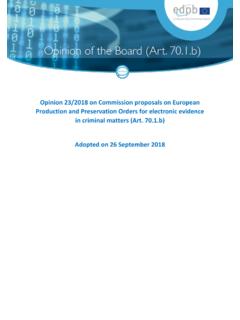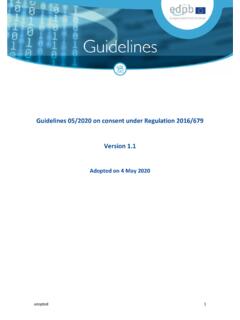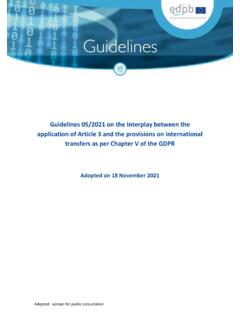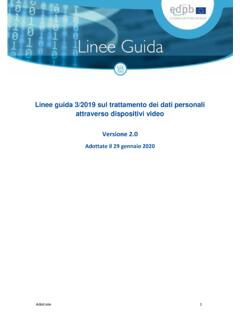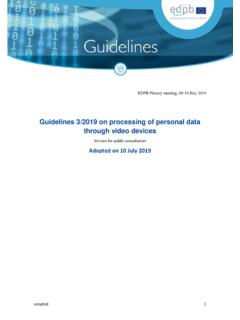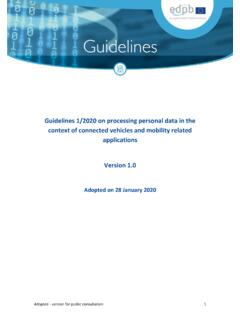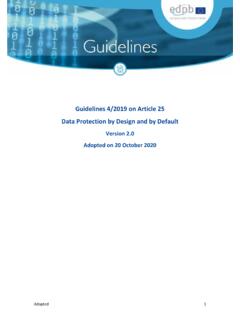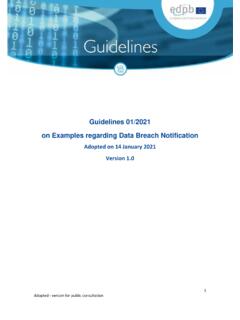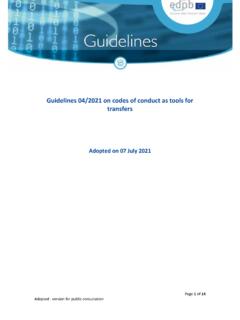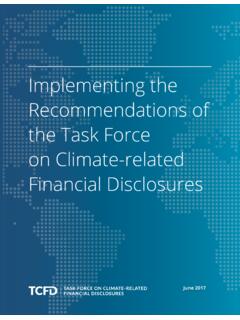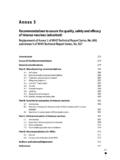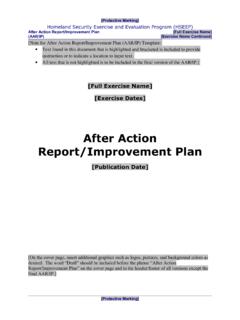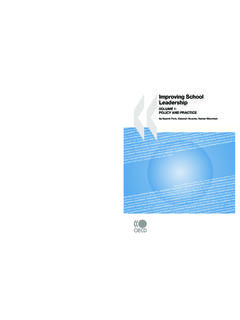Transcription of Recommendations 01/2020 on measures that supplement ...
1 Recommendations 01/2020 on measures that supplement transfer tools to ensure compliance with the EU level of protection of personal data Version Adopted on 18 June 2021. Adopted 1. Version history Version 18 June 2021 Adoption of the Recommendations after public consultation Version 10 November 2020 Adoption of the Recommendations for public consulation Adopted 2. Executive summary The EU General Data Protection Regulation (GDPR) was adopted to serve a dual-purpose: facilitating the free flow of personal data within the European Union, while preserving the fundamental rights and freedoms of individuals, in particular their right to the protection of personal data. In its recent judgment C-311/18 (Schrems II) the Court of Justice of the European Union (CJEU) reminds us that the protection granted to personal data in the European Economic Area (EEA) must travel with the data wherever it goes. Transferring personal data to third countries cannot be a means to undermine or water down the protection it is afforded in the EEA.
2 The Court also asserts this by clarifying that the level of protection in third countries does not need to be identical to that guaranteed within the EEA but essentially equivalent. The Court also upholds the validity of standard contractual clauses, as a transfer tool that may serve to ensure contractually an essentially equivalent level of protection for data transferred to third countries. Standard contractual clauses and other transfer tools mentioned under Article 46 GDPR do not operate in a vacuum. The Court states that controllers or processors, acting as exporters, are responsible for verifying, on a case-by-case basis and, where appropriate, in collaboration with the importer in the third country, if the law or practice of the third country impinges on the effectiveness of the appropriate safeguards contained in the Article 46 GDPR transfer tools. In those cases, the Court still leaves open the possibility for exporters to implement supplementary measures that fill these gaps in the protection and bring it up to the level required by EU law.
3 The Court does not specify which measures these could be. However, the Court underlines that exporters will need to identify them on a case-by-case basis. This is in line with the principle of accountability of Article GDPR, which requires controllers to be responsible for, and be able to demonstrate compliance with the GDPR. principles relating to processing of personal data. To help exporters (be they controllers or processors, private entities or public bodies, processing personal data within the scope of application of the GDPR) with the complex task of assessing third countries and identifying appropriate supplementary measures where needed, the European Data Protection Board (EDPB) has adopted these Recommendations . These Recommendations provide exporters with a series of steps to follow, potential sources of information, and some examples of supplementary measures that could be put in place. As a first step, the EDPB advises you, exporters, to know your transfers.
4 Mapping all transfers of personal data to third countries can be a difficult exercise. Being aware of where the personal data goes is however necessary to ensure that it is afforded an essentially equivalent level of protection wherever it is processed. You must also verify that the data you transfer is adequate, relevant and limited to what is necessary in relation to the purposes for which it is processed. A second step is to verify the transfer tool your transfer relies on, amongst those listed under Chapter V GDPR. If the European Commission has already declared the country, region or sector to which you are transferring the data as adequate, through one of its adequacy decisions under Article 45 GDPR or under the previous Directive 95/46 as long as the decision is still in force, you will not need to take any further steps, other than monitoring that the adequacy decision remains valid. In the absence of an adequacy decision, you need to rely on one of the transfer tools listed under Articles 46 GDPR.
5 Only in some cases you may be able to rely on one of the derogations provided for in Article 49 GDPR if you meet the conditions. Derogations cannot become the rule in practice, but need to be restricted to specific situations. A third step is to assess if there is anything in the law and/or practices in force of the third country that may impinge on the effectiveness of the appropriate safeguards of the transfer tools you are relying on, in the context of your specific transfer. Your assessment should be focused first and foremost on third country legislation that is relevant to your transfer and the Article 46 GDPR transfer tool you are relying on. Examining also the practices of the third country's public authorities will allow Adopted 3. you to verify if the safeguards contained in the transfer tool can ensure, in practice, the effective protection of the personal data transferred. Examining these practices will be especially relevant for your assessment where: (i) legislation in the third country formally meeting EU standards is manifestly not applied/complied with in practice.
6 (ii) there are practices incompatible with the commitments of the transfer tool where relevant legislation in the third country is lacking;. (iii) your transferred data and/or importer fall or might fall within the scope of problematic legislation ( impinging on the transfer tool's contractual guarantee of an essentially equivalent level of protection and not meeting EU standards on fundamental rights, necessity and proportionality). In the first two situations, you will have to suspend the transfer or implement adequate supplementary measures if you wish to proceed with it. In the third situation, in light of uncertainties surrounding the potential application of problematic legislation to your transfer, you may decide to: suspend the transfer; implement supplementary measures to proceed with it; or alternatively, you may decide to proceed with the transfer without implementing supplementary measures if you consider and are able to demonstrate and document that you have no reason to believe that relevant and problematic legislation will be interpreted and/or applied in practice so as to cover your transferred data and importer.
7 For evaluating the elements to be taken into account when assessing the law of a third country dealing with access to data by public authorities for the purpose of surveillance, please refer to the EDPB. European Essential Guarantees Recommendations . You should conduct this assessment with due diligence and document it thoroughly. Your competent supervisory and/or judicial authorities may request it and hold you accountable for any decision you take on that basis. A fourth step is to identify and adopt supplementary measures that are necessary to bring the level of protection of the data transferred up to the EU standard of essential equivalence. This step is only necessary if your assessment reveals that the third country legislation and/or practices impinge on the effectiveness of the Article 46 GDPR transfer tool you are relying on or you intend to rely on in the context of your transfer. These Recommendations contain (in annex 2) a non-exhaustive list of examples of supplementary measures with some of the conditions they would require to be effective.
8 As is the case for the appropriate safeguards contained in the Article 46 transfer tools, some supplementary measures may be effective in some countries, but not necessarily in others. You will be responsible for assessing their effectiveness in the context of the transfer, and in light of the third country law and practices and the transfer tool you are relying on, as you will be held accountable for any decision you take on that basis. This might also require you to combine several supplementary measures . You may ultimately find that no supplementary measure can ensure an essentially equivalent level of protection for your specific transfer. In those cases where no supplementary measure is suitable, you must avoid, suspend or terminate the transfer to avoid compromising the level of protection of the personal data. You should also conduct this assessment of supplementary measures with due diligence and document it.
9 A fifth step is to take any formal procedural steps the adoption of your supplementary measure may require, depending on the Article 46 GDPR transfer tool you are relying on. These Recommendations specify some of these formalities. You may need to consult your competent supervisory authorities on some of them. The sixth and final step is to re-evaluate at appropriate intervals the level of protection afforded to the personal data you transfer to third countries and to monitor if there have been or there will be any Adopted 4. developments that may affect it. The principle of accountability requires continuous vigilance of the level of protection of personal data. Supervisory authorities will continue exercising their mandate to monitor the application of the GDPR. and enforce it. Supervisory authorities will pay due consideration to the actions exporters take to ensure that the data they transfer is afforded an essentially equivalent level of protection.
10 As the Court recalls, supervisory authorities will suspend or prohibit data transfers in those cases where they find that an essentially equivalent level of protection cannot be ensured, following an investigation or a complaint. Supervisory authorities will continue developing guidance for exporters and coordinating their actions in the EDPB to ensure consistency in the application of EU data protection law. Adopted 5. TABLE OF CONTENTS. 1 Accountability in data transfers .. 9. 2 Roadmap: applying the principle of accountability to data transfers in practice .. 10. Step 1: Know your transfers .. 10. Step 2: Identify the transfer tools you are relying on .. 11. Step 3: Assess whether the Article 46 GDPR transfer tool you are relying on is effective in light of all circumstances of the 14. Step 4: Adopt supplementary measures .. 21. Step 5: Procedural steps if you have identified effective supplementary measures .
